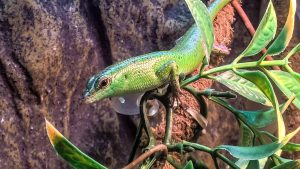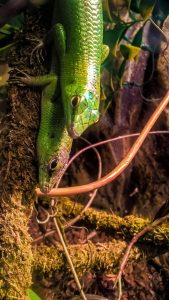
I’m excited to introduce you guys to Ryan Chermel, owner of Borayus Exotics! He’s not only a knowledgeable reptile guy but he’s also doing us and our environment a huge service by raising captive bred lizards. This is a subject close to my heart as many reptiles found in your average pet store are ripped from their homes in the wild and most die in transit before ever reaching the store. It’s unthinkably cruel and heartbreaking. Reputable, eco-conscious breeders like Ryan are hard to find and I’m pleased to bring him here today to share his experiences with Emerald Tree Skinks with you.
The Emerald Tree Skink
by Ryan Chermel
The enigmatic and sometimes eccentric and rarely shy Emerald Tree Skink (Lamprolepis smaragdina) is a wonder to behold in any collection. This species mainly comes into the USA from importers that snatch the skinks from one of their various localities, as they are widespread through eastern Indonesia, ranging from Lombok and Sulawesi in the west to New Guinea in the east. It also occurs in the Philippines and Solomon Islands, Admiralty Islands and Marshall Islands. While captive populations are established and thriving, the skink has yet to see any keepers produce the bloodlines effectively. The coloration may vary greatly within populations of different localities. The most stunning specimens are a vibrant green color throughout, hence the name, emerald tree skink, with a slightly paler belly. Others may be bluish or brown, sometimes spotted with pale or dark spots, especially on their feet. The body is moderately robust, and in captivity, it can be very robust, as these critters will eat everything in sight, and the snout is long and pointed. Small ear openings can be seen mid-way between the snout and the forelimb on either side of the head.
Their curious nature is what makes this species of skink truly intriguing to watch. Their activities vary from interacting with one another through many different series of head-bobbing ceremonies that seem to transform the skinks from lizards to jackhammers in mere moments, and they also participate in tug-o-war matches against one another when food enters the cage, and will sometimes even chase one another around. No matter what is going on around them, you better believe that these observant little critters are aware of it!

A male tree skink is a peculiarly interesting lizard to watch. If a female is present in his immediate area, one of two things may happen: He may sit on her back and try to sleep there, or he may engage in a series of intense head-bobbing that is noted above and, from there, he may chase her around endlessly, clamping down onto her feet as he tries to court her. The entire enclosure can quickly turn into a green blur if you are housing a decently sized colony together because once that male starts running, nobody wants to get in his way. With that being said, males can be housed together quite successfully, however I strongly urge any future tree skink keepers to have a group with far more females than males to protect the males from displaying aggression towards one another. Another thing that can help to ease the pressures of housing multiple males together in one vivarium is to make sure that the vivarium is quite sizeable for the males to establish their “territories” which are not traditional in any sense, and can be quite hard to identify for the first few weeks of having the skinks. The males and females will find particular spots that they enjoy, and they will go to them in the early morning and in the evening to rest. However, as with many colony based lizards, they will irritate one another, so sometimes “territories” are invaded by other obnoxious members of the group. Oftentimes, the sunny disposition of these lizards shines through, for they will slink away from the situation instead of confronting one another under most circumstances and they will move along like this, kind of in a slow manner, until they find a new position to perch up along and rest.
I have found that an enclosure that is 3’ tall by 2’ deep by 3’ long tend to suit these mostly arboreal skinks the best. It is also very important to provide them several forms of climbing materials so that they can move vertically as they would in the wild. An emphasis, or extreme effort does not need to be made when it comes to providing places to hide, however, since these animals generally settle in quite quickly!
These skinks go through many different cycles of energy during the day. While observing my colony over the past year, I noticed that they follow a particular pattern of high energy followed by the entire group slowing down and relaxing. The most humorous activity that they partake in is when one member of the group makes a sudden movement and then, all of the sudden; the attention of all of the members of the group is gained instantaneously as three pairs of eyes immediately pop open.
The intelligence that these lizards display is quite remarkable, especially when you consider how small that they are. From snout to vent, these lizards, when fully grown are around 3-4.5 inches. The total body length averages are between 8-10 inches on average. There is no true determining size difference between males and females in this particular species. Instead, the only dimorphism that I have recognized is the yellowing of the foot pads on the rear legs of the males. The females will have grey/silver with black speckle marks across their rear feet. Displays of intelligence come in the common form, for, like most lizards, the tree skink is a visual learner. Their social structure is very intriguing, yes, but their ability to learn circles around food. When I first obtained my group of skinks, I had them set up in a large Exo Terra vivarium. After only a few weeks, they recognized the sound of my door when I came in the room, and knew the look of the cricket bags / the appearance of the bin for the superworms / the bowl I would feed their fruits to them out of. Once one spotted the food in my hands, it would creep up to the borderline of the doors, then the others would quickly notice the behavior and take notice of the food as well and before I would even make it to the door, I would have five skinks staring me down, some with their front legs pressing the glass, some members of the group pacing back and forth excitedly. The skinks also surprised me when they were not skittish. Once they began to make the association with me and the coming of food for them, I was able to move things around in their enclosure without any kamikaze escapades. With that being said, the skink’s diet makes it an opportunistic predator, eating anything that it can get its jaws on. It will also eat select fruits, berries, mango, banana, sweeter fruits in general.
It’s Cyani again – Thanks Ryan! To any of my readers, if you’d like to contact Ryan about Emerald Tree Skinks or other lizards click here: Ryan Chermel or Borayus Exotics